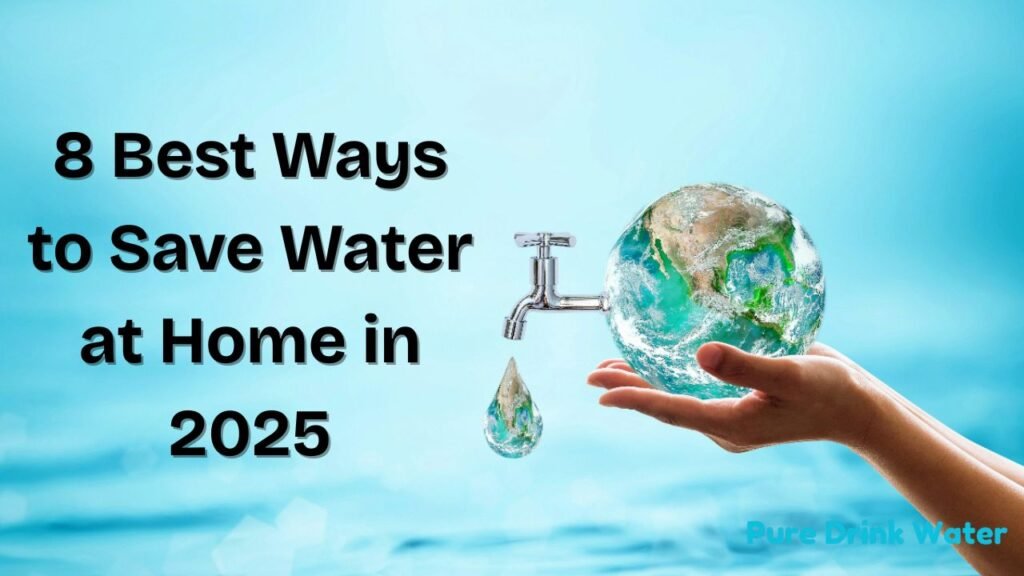
Saving water at home is crucial for both environmental sustainability and reducing utility bills. Here are 8 Best Ways to Save Water at Home in 2025. Water is getting more valuable, so it’s important to use less at home. With more people and changing weather, saving water helps a lot. Luckily, there are easy and cheap ways to do this in 2024.
From simple habits to new gadgets, these eight tips will help you save water, cut down on bills, and be kind to the environment. Let’s see how you can start saving water at home today.
8 Best Ways to Save Water at Home in 2025
Table of Contents
1. Install Low-Flow Fixtures:
Upgrade to low-flow showerheads, faucets, and toilets. Modern designs are efficient and can significantly reduce water usage without sacrificing performance.
Why You Should Install Low-Flow Fixtures in Your Home
If you’re looking for an easy way to save water and cut down on your bills, installing low-flow fixtures is a great place to start. Low-flow fixtures are designed to use less water but still work well. Here’s why they’re a smart choice and how they can help you and the environment.
Types of Low-Flow Fixtures
- Low-Flow Showerheads: These showerheads use less water, usually no more than 2.5 gallons per minute (GPM). This is a big drop from older models that might use up to 5 GPM.
- Low-Flow Faucets: Faucet aerators or low-flow faucets use around 1.5 to 2.2 GPM, compared to the standard 2.5 GPM. They mix air with the water to keep pressure up while using less water.
- Low-Flow Toilets: These toilets use only 1.28 gallons per flush (GPF), compared to older ones that use 3.5 to 7 GPF. Some models let you choose a smaller flush for liquid waste.
How to Get Started
Look at your home and find the fixtures that use the most water. Start by replacing the old ones with low-flow options. For example, changing an old toilet to a low-flow model can make a big difference.
2. Upgrade to a High-Efficiency Washing Machine:
Look for washing machines with high-efficiency ratings. They use less water per load compared to older models.
Why You Should Upgrade to a High-Efficiency Washing Machine
If you want to save money on your water and energy bills and help the environment, upgrading to a high-efficiency (HE) washing machine is a great idea. These modern machines offer many benefits that make them a smart choice for your home.
Benefits of an HE Washer
- Lower Bills: By using less water and energy, you’ll pay less on your utility bills. The savings add up over time, making it a good investment.
- Eco-Friendly: Using less water and energy helps reduce your impact on the environment.
- Better Cleaning: HE washers often clean clothes better and use less detergent. They can handle bigger loads, so you do fewer washes.
- Convenience: Many HE washers come with extra features like smart technology that lets you control your laundry from your phone.
3. Fix Leaks Promptly:
Regularly check for and repair leaks in faucets, toilets, and pipes. Even small leaks can waste a lot of water over time.
Why You Should Fix Leaks Quickly
A leaky faucet or pipe might seem like a small problem, but it can lead to bigger issues if not fixed soon. Fixing leaks quickly is an easy way to save water, reduce your bills, and protect your home.
How to Fix Leaks
- Find the Leak: Look for leaks around faucets, toilets, and pipes. Check for water stains, puddles, or dripping sounds.
- Turn Off the Water: For bigger leaks, turn off the water supply to avoid more damage while you repair the leak.
- Fix or Replace: Depending on the leak, you might need to tighten fittings, replace washers, or fix pipes. Some repairs are simple, but for tough problems, it’s best to call a plumber.
- Check Regularly: Inspect your plumbing and fixtures often for signs of leaks or wear. Catching problems early can prevent bigger issues.
4. Use a Water-Efficient Dishwasher:
Newer dishwashers are designed to use less water and energy. Make sure to run full loads to maximize efficiency.
Why You Should Use a Water-Efficient Dishwasher
Switching to a water-efficient dishwasher is a great way to save water, cut down on your bills, and help the environment. Here’s why it’s a smart choice:
How to Choose a Water-Efficient Dishwasher
- Look for the Energy Star Label: Dishwashers with this label are proven to be water and energy-efficient.
- Consider the Size: Pick a size that fits your needs. Larger models can wash more dishes at once, which is great for families.
- Check Features: Features like adjustable racks and eco-friendly wash cycles can make the dishwasher even more efficient.
- Read Reviews: Check what other people say about the dishwasher to make sure it works well and is reliable.
5. Implement Smart Irrigation Systems:
Invest in smart irrigation controllers that adjust watering schedules based on weather conditions and soil moisture levels.
Why You Should Use a Smart Irrigation System
Smart irrigation systems are a great way to water your garden or lawn more efficiently. They use technology to save water, cut costs, and keep your plants healthy. Here’s why you might want to consider one for your home.
How to Set Up a Smart Irrigation System
- Figure Out Your Needs: Think about the size of your garden or lawn and what types of plants you have. This will help you choose the right system.
- Research Options: Look at different smart irrigation systems, compare their features and prices, and read reviews to find the best one.
- Install the System: You can install it yourself or hire a professional. Follow the instructions carefully to set it up correctly.
- Monitor and Adjust: After installation, keep an eye on how it’s working and make any needed adjustments. Check for updates to the system’s software to keep it running smoothly.
6. Collect Rainwater:
Rain barrels are used to collect rainwater for watering plants and gardens. This reduces your reliance on tap water for irrigation.
Why You Should Collect Rainwater
Collecting rainwater is an easy way to save water, cut down on your bills, and help the environment. You can make a positive impact at home by capturing and using rainwater. Here’s why and how to get started.
Tips for Collecting Rainwater
- Check Local Rules: Some places have rules about collecting rainwater. Make sure you’re following any local guidelines.
- Monitor Water Levels: Keep track of how much rainwater you have. During dry periods, you might need to use more tap water.
- Maintain Your System: Clean your barrel or tank regularly and check for any damage. Good maintenance helps keep your system working well.
- Watch for Pollution: Avoid collecting rainwater if your roof or gutters are polluted, as this can affect the water quality.
7. Practice Water-Efficient Landscaping:
Choose drought-tolerant plants and use mulch to retain soil moisture. This minimizes the need for frequent watering.
How to Practice Water-Efficient Landscaping
Water-efficient landscaping helps you create a beautiful yard or garden while using less water. This approach can save you money, help the environment, and make your garden easier to maintain. Here’s how you can practice water-efficient landscaping.
Tips for Water-Efficient Landscaping
- Choose Drought-Tolerant Plants: Pick plants that need less water and are suited to your local climate. Native plants are usually a good choice.
- Group Plants by Water Needs: Plant plants with similar water needs together. This makes watering more efficient and avoids wasting water.
- Use Mulch: Put mulch around your plants to keep the soil moist and reduce evaporation. Mulch also helps control weeds.
- Use Efficient Irrigation: Install drip irrigation or soaker hoses to water plants directly at their roots. These systems use water more efficiently than sprinklers.
- Water Early or Late: Water your garden in the early morning or late evening to avoid losing water to evaporation in the heat of the day.
- Install Rain Barrels: Collect rainwater from your roof with rain barrels. You can use this rainwater to water your garden, reducing the need for tap water.
- Design for Efficiency: Shape your garden beds to direct water to plant roots and avoid areas where water might run off or pool.
- Maintain Your System: Regularly check and fix your irrigation system. Make sure there are no leaks and that the system is working properly.
Reduce Shower Time:
Shorten your showers and consider installing a timer or water-saving showerhead to help limit usage.
How Reducing Shower Time Can Save Water and Money
Taking shorter showers is an easy way to save water, lower your bills, and help the environment. Even small changes can make a big difference. Here’s why and how you should consider cutting down your shower time.
Tips for Shorter Showers
- Set a Timer: Use a timer or alarm to keep track of your shower time. Aim for 5 to 10 minutes.
- Be Quick: Try to shower quickly without spending too much time. Focus on getting clean efficiently.
- Install a Water-Efficient Showerhead: These showerheads use less water but still provide good pressure. They help you save water without affecting your shower experience.
- Turn Off Water While Lathering: Turn off the shower while you shampoo or soap up, then turn it back on to rinse off. This helps you use less water.
- Prefer Showers Over Baths: Showers generally use less water than baths. Opt for shorter showers instead of long baths.
- Use a Shower Timer: Consider getting a shower timer that attaches to your shower. It can help remind you to keep your showers short.
- Be Mindful: Pay attention to how long you’re in the shower and make an effort to keep it brief.
conclusion
8 Best Ways to Save Water at Home, but it can make a big difference. Start by upgrading non-standard items like showers and faucets to use less water and save money. Upgrading to a better washing machine will also save you water, energy and money. Fixing leaks quickly can prevent water contamination and damage to your home. When buying a new dishwasher, choose a waterproof model to save water and money. Keep your plants well watered by using a smart irrigation system. Collecting rainwater in bottles is an easy way to reduce water consumption. Cooling down and spending less time in the shower is also a great way to conserve water. By making these changes, you can help the environment and reduce your energy bills.





